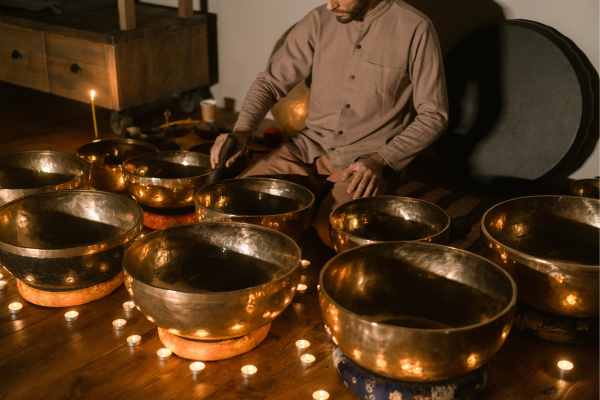Introduction
In a world filled with constant distractions and the hustle and bustle of modern life, it’s easy to become overwhelmed and disconnected from the present moment OR to get super invested in things “going a certain way.”
Mindfulness, a practice rooted in ancient traditions and popularized by figures like Jon Kabat-Zinn, offers a way to regain that connection and find inner peace. This blog explores the fundamentals of mindfulness, with a focus on Jon Kabat-Zinn’s “non-judgmental mindfulness on purpose” framework. We’ll also delve into the concept of “non-attachment” from a Buddhist standpoint and discuss three practical ways to incorporate this type of mindfulness into your daily life.
The Essence of Mindfulness
Mindfulness is more than just a trendy buzzword; it’s a transformative practice that can lead to improved mental and emotional well-being. At its core, mindfulness involves paying deliberate attention to the present moment, without judging the present moment. This means fully immersing yourself in your experience and simply observing your thoughts, feelings, bodily sensations, and surroundings, without trying to change, analyze, or judgmentally label them.
Jon Kabat-Zinn’s Non-Judgmental Mindfulness on Purpose
Jon Kabat-Zinn, a pioneer in the field of mindfulness in the West, developed the Mindfulness-Based Stress Reduction (MBSR) program for clients who were in chronic pain or dealing with chronic illness. He defines mindfulness as “awareness that arises through paying attention, on purpose, in the present moment, non-judgementally….And then I sometimes add, in the service of self-understanding and wisdom.” At it’s core, it’s about emphasizing the importance of cultivating “non-judgmental mindfulness on purpose.”
This approach involves observing your thoughts and experiences without attaching value judgments or labels to them. When we practice non-judgmental mindfulness, we accept whatever arises in our awareness with curiosity and compassion, rather than trying to categorize it as good or bad.
Non-Judgment and Buddhist Non-Attachment
The concept of non-judgmental mindfulness shares common ground with the Buddhist principle of “non-attachment.” In Buddhism, non-attachment refers to the idea of not clinging to or craving for things, experiences, or outcomes. Non-attachment doesn’t mean detachment from life but rather a freedom from the suffering caused by our attachments.
Think of “attachment” like being super invested in a particular outcome due to what we tell ourselves it means. Examples include ‘making sure’ our kids get into a specific college, ‘making sure’ we get a particular anniversary gift, etc.
When practicing mindfulness, especially in the non-judgmental way advocated by Kabat-Zinn, you learn to let go of attachments to your thoughts and emotions. Instead of becoming entangled in the stories your mind creates, you observe them from a distance, recognizing that they are transient and impermanent. This aligns with the Buddhist belief that attachment leads to suffering, as we inevitably encounter loss and change in life.
The Cognitive Behavioral Therapy skill of ‘thought defusion’ captures the essence of this noticing. You can find a link for the exercise here.
Three Ways to Practice Non-Judgmental Mindfulness
Mindful Breathing:
- Begin by finding a quiet and comfortable place to sit or lie down. Close your eyes and bring your attention to your breath. Observe each inhale and exhale without trying to change it. If your mind starts to wander or judgments arise, gently observe “thinking,” and redirect your focus back to your breath. Notice any bodily sensations, thoughts, or emotions that surface, but let them pass without judgment.
Body Scan:
- Lie down in a relaxed position, close your eyes, and bring your awareness to different parts of your body, starting from your toes and moving up to your head. As you scan each body part, observe any sensations, tensions, or discomfort without trying to change them. This practice helps you become more attuned to your body and cultivate non-judgmental awareness and self-trust.
Mindful Observation “One Thing Mindfully”:
- Take a few minutes to sit in a quiet place, and choose an object in your environment to focus on. It could be a flower, a piece of artwork, or any ordinary item. Concentrate on this object, paying attention to its details, colors, and textures, scent, size, etc.. Allow yourself to experience it fully without evaluating or analyzing it. This exercise helps sharpen your ability to be present without judgment.
Conclusion
Mindfulness, with its foundation in non-judgmental awareness, offers a powerful antidote to the stress and busyness of modern life. Jon Kabat-Zinn’s “non-judgmental mindfulness on purpose” framework aligns with the Buddhist principle of non-attachment, guiding us towards greater acceptance and freedom from suffering. By incorporating practices like mindful breathing, body scanning, and mindful observation into our daily lives, we can begin to experience the profound benefits of mindfulness and cultivate a deeper connection with the present moment. As we let go of judgments and attachments, we embark on a journey toward greater inner peace, balance, and well-being.
Connect with Me
If you’re interested in learning more about these types of tools, skills, and techniques, head over to my coaching website or schedule a call with me here.
You can also follow me on my socials @shannanblummft, or request to join my new FB group “Women Healing into Wholeness” where I’ll be providing tons of free content and trainings.
In Health & Wholeness,
Shannan
